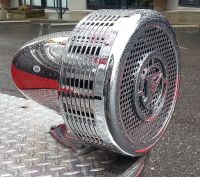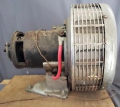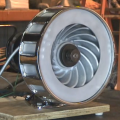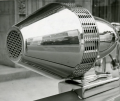Q-Siren
| Q-Siren | |

| |
| Company | |
|---|---|
| Produced | 1951-present |
| Type | Omnidirectional Electromechanical |
| Sound output | 123 dB @ 10 ft |
| Voltage | 12 V DC |
| Documentation | Manual |
The Q-Siren is an electromechanical vehicular siren produced by Federal Signal and has been extremely popular with fire stations across the country since its introduction. The siren has one of the most recognizable sounds in the United States, with its sound being trademarked by Federal Signal. Despite many mechanical vehicular sirens being phased out in favor of electronic ones, the Q2B still has a large foothold in the market. The Q2B was compatible with the Pulsator attachment for pulsed signals.
History
The Q-Siren was designed in 1951 by Federal salesman Bill Scott. Originally, the Q-Siren made use of a 10-port rotor and stator, with the rotor featuring straight vanes like Federal's other vehicular sirens. On these earlier models, the brake was located in the base of the siren, before being moved elsewhere. Federal likely was unhappy with its performance, as by the late 1950s, the Q-Siren was redeveloped into a 14-port siren with curved rotor vanes to improve performance, heavily reminiscent of B&M's Air Raid and Siro-Drift sirens. Federal may have been inspired by B&M's vehicular sirens, as B&M was enjoying significant popularity in the market at the time due to the high performance of their sirens. The redesigned Q-Siren was specifically intended to outperform most vehicular sirens of the time and as such rapidly gained popularity due to its high performance and shrill sound. It was sold alongside the Class C and Class V vehicular sirens before ultimately replacing them by the 1970s. In recent years, Federal Signal has also began offering a chrome variant with a blackened finish, which is better suited for fire engines that have black painted bumpers. The Q-Siren is still sold by Federal Signal to this day and has proved to be one of the most popular mechanical vehicular sirens in service today. Its main competitors are B&M's Siro-Drift series, Eagle Siren's Screaming and Nesting Eagle sirens, and various other smaller manufacturers. The early 10-port Q-Siren is very rare, with only one or two known surviving units.
Design
All Q-Sirens are driven by a 12 V DC motor, which operates at a high speed to drive a 14-port rotor with curved vanes. Every Q siren uses roughly the same design, with finger guards on each stator port, and a mesh screened intake assembly bolted to the front of the stator with Federal's original Federal Electric logo featured prominently in the middle. The intake and finger guards are 1 piece, attached to the stator. Model Q2 sirens have a bullet-shaped motor cover to protect the motor, while Model Q1 sirens lack these. The siren normally comes with a pedestal mount, though the siren can be ordered without one if it will be mounted inside a truck's bumper. The siren is available with a heavy-duty coaster clutch, which allows the siren to coast for a long period of time after being shut off, in order to reduce battery drainage. Clutch-equipped Q-sirens are also equipped with electric brakes to quickly bring the rotor to a halt when the siren needs to be silenced. These clutches are rather unreliable due to their parts being outsourced. The Q-Siren is typically finished with chrome, giving it a clean, distinctive appearance, although it could also be painted instead. The Q-Siren is available in a wide variety of different configurations, including pedestal mounted models, flush-mounted bumper models, and different finishes. The basic naming terminology of Q-Siren models are as follows:
- Model Q = Siren model
- 1 = Painted, motor exposed with no motor cover.
- 2 = Chrome, with bullet-shaped rear motor cover
- A = No brake/clutch, free rolling
- B = Equipped with a brake/clutch
- Model P-Q1/20A/B = Equipped with a Pulsator
Gallery
-
A 10-port Model Q1A, 1 of 2 known to exist.
-
A Model Q2A with the intake, finger guards and motor cover removed.
-
A Model PQ20B, which is a Model Q2B equipped with a Pulsator that causes the siren to rapidly pulsate using a rotor-driven flapper.


